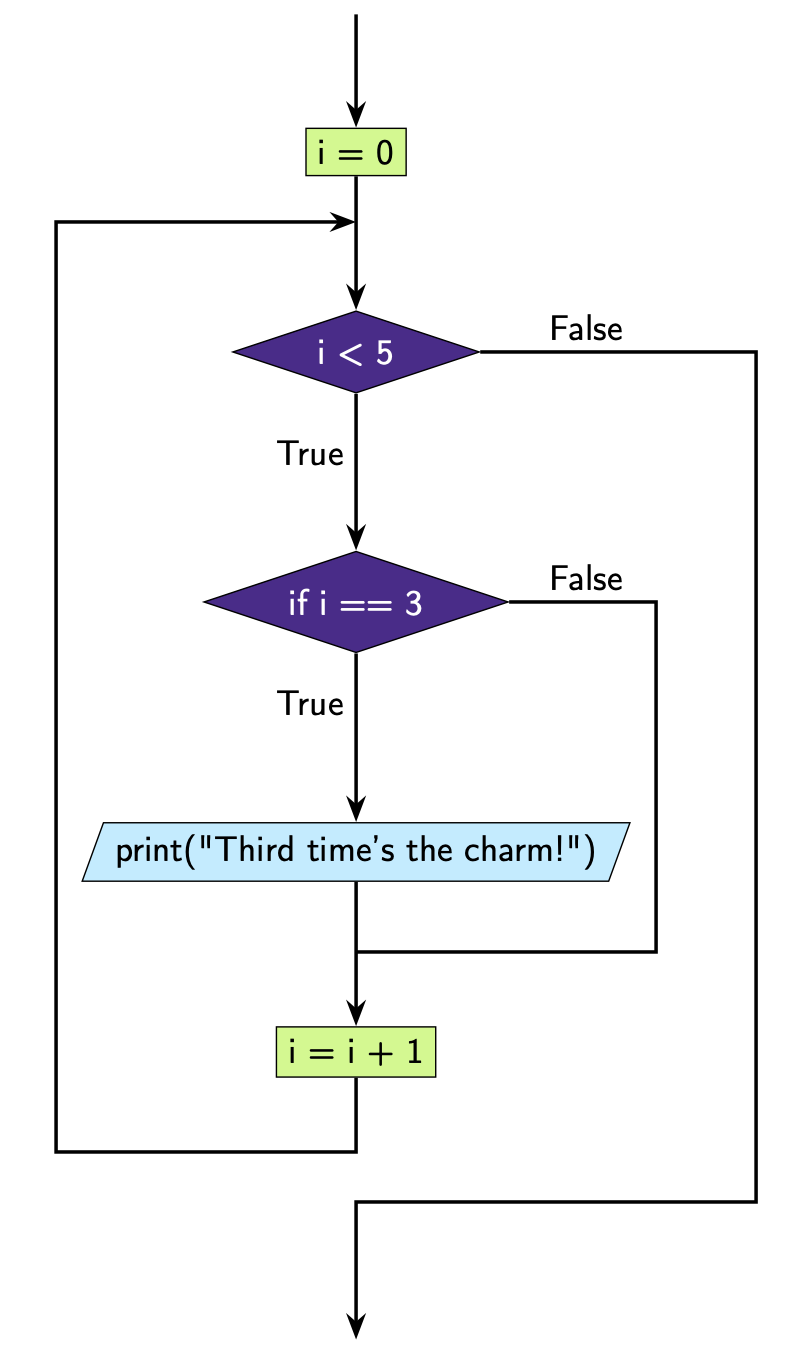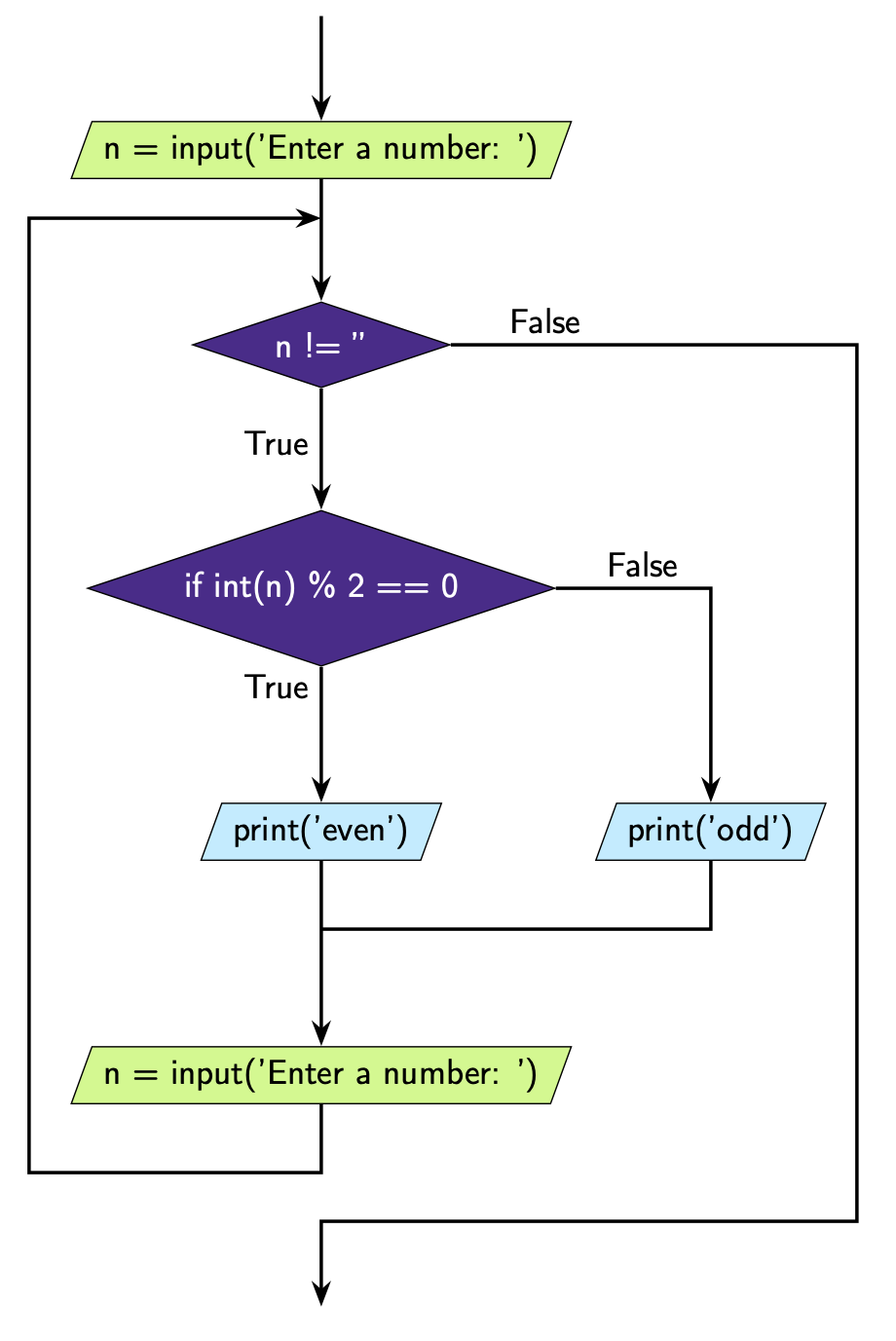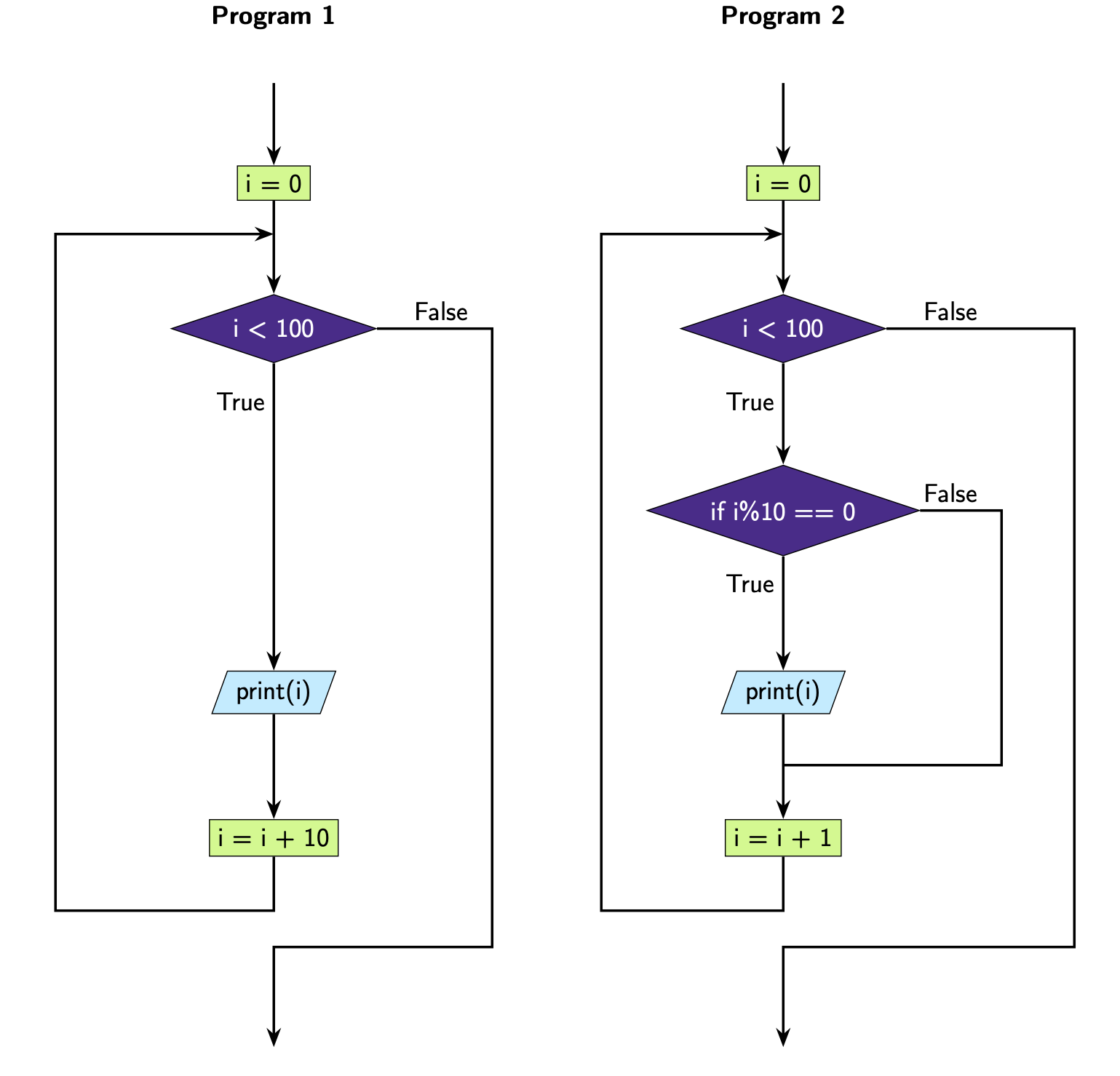3.11. While Loops With Conditionals#
So far the loops we have looked at have had simple blocks of code inside the loop, i.e. the blocks that were being repeated were quite simple. What you’ll see is that the code inside the loop can be as complicated as you’d like. For example, we can add conditionals inside the loop.
Here’s an example with an if statement.
i = 0
while i < 5:
print(i)
if i == 3:
print("Third time's the charm!")
i = i + 1
0
1
2
3
Third time's the charm!
4
What’s happening here?
We can see that the condition we have set for our while loop is i < 5.
At the first iteration i = 0. This means the loop condition is
True. We execute the code block:
print(i)
if i == 3:
print("Third time's the charm!")
i = i + 1
This means that we output:
0
Then since the condition i == 3 is False, we increment i and move
onto the next iteration.
At the second iteration i = 1. This means the loop condition is
True. Again, we execute the code block and we output:
1
Then since the condition i == 3 is False, we increment i and move
onto the next iteration.
At the third iteration i = 2. This means the loop condition is
True. Again, we execute the code block and we output:
2
Then since the condition i == 3 is False, we increment i and move
onto the next iteration.
At the fourth iteration i = 3. This means the loop condition is
True. Again, we execute the code block and we output:
3
This time the condition i == 3 is True, so we also output:
Third time's the charm!
We increment i and move onto the next iteration.
At the fifth iteration i = 4. This means that the loop condition is
True. Again, we execute the code block and we output:
4
Then since the condition i == 3 is False, we increment i and move
onto the next iteration.
At the sixth iteration i = 5. This means that the loop condition is
False. We do not execute the code block.
This is how we can represent this code diagrammatically.

Note that there are two False routes running down the right hand side of
the figure. This means that there should be two levels of indentation in the
code.
Here’s an example of an if-else statement inside a loop using
input().
n = input("Enter a number: ")
while n != "":
if int(n) % 2 == 0:
print("even")
else:
print("odd")
n = input("Enter a number: ")
What you’ll notice with this loop is that this loop is going to keep asking the
user for a number. With each number, the program will check whether int(n) %
2 == 0, i.e. checks whether the number is even or not. If the number is even
the program will output:
even
otherwise it will output:
odd
This program will keep going until the user enters an empty string.

Again there are two False routes running down the right hand side of the
figure, which corresponds to two levels of indentation in the code.
Question 1
Will the following two programs produce the same output?
Program 1
i = 0
while i < 100:
print(i)
i = i + 10
Program 2
i = 0
while i < 100:
if i%10 == 0:
print(i)
i = i + 1
Solution
Let’s look at Program 1. This program is going start at i = 0 and then at each iteration i will increase by 10 since we update i with i = i + 10. Since we print each value of i, we get the output:
0
10
20
30
40
50
60
70
80
90
Note that we don’t print 100 because when i = 100 the while condition is False, the code block inside the loop doesn’t run and we exit the program.
Now let’s look at Program 2. This program is going start at i = 0 and then at each iteration i will increase by 1 since we update i with i = i + 1. This means we’ll run the loop 100 times (from i = 0, …, 99). Inside the loop we have the code block
if i%10 == 0:
print(i)
i = i + 1
This means that at each iteration we check to see whether i is divisible by 10 and if it is, we print(i). This means we get the output:
0
10
20
30
40
50
60
70
80
90
Thus, the output of program 1 and program 2 are the same even though the code is different!

Note that program 1 has one False route running down the right hand side of the figure and program 1 only has one level of indentation. Program 2 has two False routes running down the right hand side of the figure and program 2 has two levels of indentation.
Question 2
What do you think the output of the following will be?
cars = ['red', 'white', 'blue', 'white', 'blue', 'green', 'red', 'blue']
count = 0
i = 0
while i < len(cars):
if cars[i] == 'blue':
count = count + 1
i = i + 1
print(count)
Solution
Solution is locked
Question 3
What is wrong with the following code?
n = int(input())
while n != '':
if n%3 == 0:
print('divisible by 3')
n = int(input())
The indentation on
line 6does not match the indentation online 5.nis not an integer, which meansn%3inline 4results in a TypeError as you cannot take the modulus of a string.To exit the loop the user needs to enter a blank lint, but this will result in a ValueError on
line 1orline 6as you cannot convert an empty string to an integer.The code will result in an infinite loop
Solution
Solution is locked
Question 4
We want to write a program that will read integers from a user and if the integer is divisible by 3 the program will output
divisible by 3
otherwise the program will do nothing.
The program will terminate only if the user doesn’t provide input, e.g. enters an empty string.
An example of how this program might run is shown below with user input shown in bold.
4
8
9
divisible by 3
12
divisible by 3
Our first attempt at the code did not work:
n = int(input())
while n != '':
if n%3 == 0:
print('divisible by 3')
n = int(input())
Write a new program that fixes the error in our first attempt.
Solution
Solution is locked
Question 5
Code challenge: Odd Numbers
You have been provided with a list called numbers.
numbers = [5, 12, 39, 45, 2, 61, 22, 49, 50, 73, 11, 84, 32, 40, 18, 39, 85, 16, 14, 49, 99, 68, 57, 35, 66]
Write a program that loops through the lists and sums all the odd numbers. Print your result.
Solution
Solution is locked
